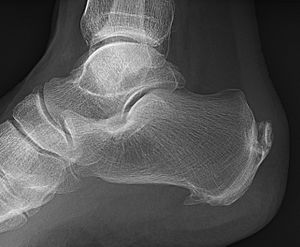Heel spur facts for kids

A heel spur is a small, bony growth that can form on your heel bone. It's often called a calcaneal spur by doctors. Imagine a tiny, sharp bump growing where your foot muscles and ligaments connect to your heel. These spurs can sometimes cause pain, especially when you walk or stand.
Contents
What is a Heel Spur?
A heel spur is a calcium deposit that grows on the underside of your heel bone. It can extend forward, sometimes up to half an inch. Heel spurs are often linked to another condition called plantar fasciitis. This is when the strong band of tissue along the bottom of your foot (the plantar fascia) becomes inflamed.
How do Heel Spurs Form?
Heel spurs develop over a long time. They are not usually caused by a sudden injury. Instead, they form when there is repeated stress and strain on the muscles and ligaments of your foot. This stress can cause tiny tears in the tissue that connects to your heel bone. Over time, your body tries to repair these tears by laying down extra calcium, which can build up into a bony spur.
Causes of Heel Spurs
Several things can increase your risk of developing a heel spur. These factors often lead to extra stress on your feet.
Foot Strain
One main cause is too much strain on the foot muscles and ligaments. This can happen from:
- Activities: Running, jumping, or other sports that put a lot of pressure on your feet.
- Walking style: An unusual way of walking can put too much stress on the heel.
- Foot structure: Having flat feet or very high arches can change how your weight is distributed.
Footwear and Weight
Your shoes and body weight also play a big role.
- Bad shoes: Wearing shoes that don't fit well or don't offer enough support can be a problem. Shoes without good arch support or cushioning can increase strain.
- Overweight: Carrying extra body weight puts more pressure on your feet, especially your heels. This added stress can lead to heel spurs.
Age and Other Factors
Heel spurs are more common as people get older. This is because the tissues in our feet can become less flexible over time. Other factors include:
- Standing a lot: Jobs that require long hours of standing on hard surfaces.
- Diabetes: Some health conditions like diabetes can affect foot health.
Symptoms of a Heel Spur
Many people with heel spurs don't feel any pain at all! The spur itself isn't always the problem. Pain usually comes from the inflammation of the soft tissues around the spur, like the plantar fascia.
Common Pain
If you do feel pain, it might be:
- Sharp pain: Often felt when you first stand up in the morning or after resting.
- Dull ache: This might turn into a dull ache that lasts throughout the day.
- Worse after activity: Pain can get worse after exercise or long periods of standing.
It's important to remember that the size of the spur doesn't always match the amount of pain. A small spur can cause a lot of pain, while a large one might cause none.
Diagnosis
If you have heel pain, a doctor can help figure out if it's a heel spur.
Medical Exam
The doctor will ask about your symptoms and examine your foot. They will check for tenderness and pain in your heel.
X-ray
An X-ray is the best way to see a heel spur. It can show the bony growth on your heel bone. However, an X-ray only shows the bone. It doesn't show the inflammation of the soft tissues, which is often the real cause of pain.
Treatment and Prevention
Most heel spurs can be treated without surgery. The main goal is to reduce pain and inflammation.
At-Home Care
Many simple steps can help:
- Rest: Avoid activities that make your heel hurt.
- Ice: Apply ice packs to your heel for 15-20 minutes several times a day.
- Stretching: Gentle stretches for your calf muscles and plantar fascia can help.
- Supportive shoes: Wear shoes with good arch support and cushioning. Avoid flat shoes or high heels.
- Orthotics: Special shoe inserts (orthotics) can help support your arch and cushion your heel.
Medical Treatments
If home care isn't enough, a doctor might suggest:
- Medication: Pain relievers or anti-inflammatory medicines can help.
- Physical therapy: A physical therapist can teach you specific exercises and stretches.
- Injections: In some cases, a doctor might give a corticosteroid injection to reduce inflammation.
Prevention Tips
To help prevent heel spurs:
- Wear supportive shoes that fit well.
- Maintain a healthy weight.
- Warm up properly before exercise.
- Stretch your feet and calf muscles regularly.
Images for kids
See also
 In Spanish: Espolón calcáneo para niños
In Spanish: Espolón calcáneo para niños


